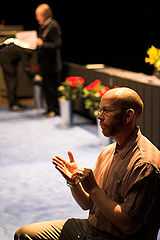Movement (sign language)
In sign language, movement, or sig, refers to the distinctive hand actions that form words. In William Stokoe's terminology, it is the SIG, an abbreviation of signation. Movement is one of five components of a sign—with handshape (DEZ), orientation (ORI), location (TAB), and facial-body expression. Different sign languages use different types of movement. Some treatments distinguish movement and hold—signs, or parts of signs, that involve motion vs. those that hold the hands still.
Movements in American Sign Language

American Sign Language uses about twenty movements. These include lateral motion in the various directions, twisting the wrist (supinating or pronating the hand), flexing the wrist, opening or closing the hand from or into various handshapes, circling, wriggling the fingers, approaching a location, touching, crossing, or stroking it, and linking, separating, or interchanging the hands. These may be repeated and made large or small and with varying degrees of speed, abruptness, and intensity.[1]
References
- ↑ Stokoe, Casterline, & Croneberg, 1965. A Dictionary of American Sign Language on Linguistic Principles, Gallaudet